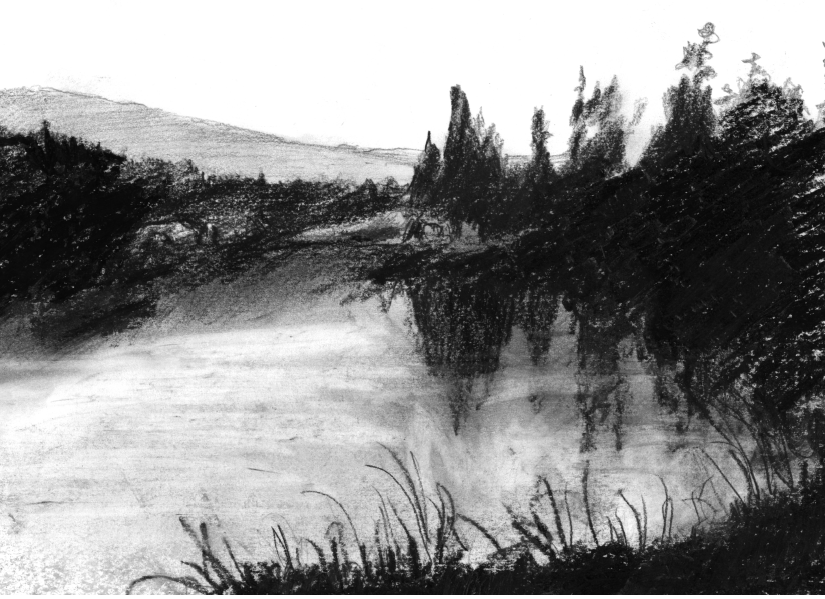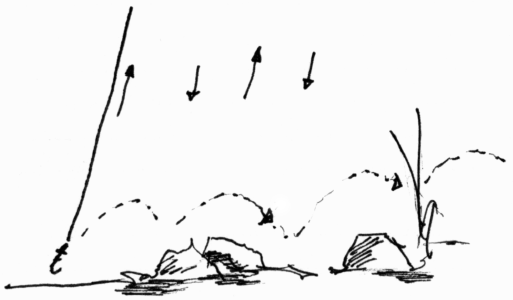

KEEP CLOSE TO NATURE’S HEART . . . AND BREAK CLEAR AWAY ONCE IN AWHILE, AND CLIMB A MOUNTAIN OR SPEND A WEEK IN THE WOODS. WASH YOUR SPIRIT CLEAN.
—John Muir
On a recent trip to a Rocky Mountain lake above tree line, I felt compelled to pack in my western five-weight as well as my tenkara rod. I was worried that the limited reach of my thirteen-foot tenkara rod wouldn’t be able to effectively fish such a large lake, especially since there was no tree cover along its shore. I shouldn’t have worried. I ended up using the tenkara rod almost exclusively and caught plenty of cutthroat and lake trout. In a week I had only two fish break off and I landed an eighteen-inch “cut” on 5X tippet. What a blast!
Large waters can be fished effectively with tenkara, though you will be limited in your reach and in the size of the fish you can land. Mostly it requires rethinking how you fish. Start by imagining the water divided into smaller reachable sections. Plan to fish the sections as if they were smaller water. Where are the prime lies? Where do I need to be to fish it and how do I approach?
The chutes that enter or drain lakes can be very productive fishing locations; food is concentrated at inlets and outlets and fish congregate on the flats to either side. This part of a lake is generally easy to approach and is nearly always the location most likely to contain feeding fish.
Drop-offs and points can be fished with tenkara too. These areas offer fish a place to retreat and hide quickly even while presenting more fecund beds for feeding. These shallows are warmed by the sun early in the season and early in the day, allowing you to fish when the rest of a lake is “asleep.” If there is a choice, fish the leeward side of a lake; wind often pushes the warmer surface layers and drifting insects in that direction.
In lakes with weed beds, fishing the openings and along the current breaks can be aided by the long reach of a tenkara rod. With very small openings you can actually drop a fly in these patches, something you might not reach with a short rod. Never forget, fish concentrate at the “edges,” the areas most effectively prospected with tenkara, even on lakes.
Tenkara rods are a lot of fun from a float tube too, a method of fishing that opens up most of the rest of the shoreline and the drop-offs. Because you are low to the water, the long tenkara rod helps clear your cast much better than a short rod. In a windy environment, a heavier, level line (say, a seventeen-pound fluorocarbon) will usually be more effective than a furled line. Keep your flipper movements subtle and slow or you will start to miss the longer reach of a western rod. The lateral line of a fish is very sensitive to water pressure waves.
Bigger rivers can be fished with tenkara rods too. Just think of the river as being divided into several small streams. Keep your focus close at hand and move patiently. Fish the bank and the pocket water. Don’t forget to use a wading staff in heavier water. It is always a good idea to wade by quartering upstream in a river you don’t know. If you start to get in deeper than you’d like, you can back down with the current rather than getting in a predicament fighting the current. Keep your wading belt snug in big water too. A fall in faster streams can be dangerous, especially if you fill your waders with icy water. As mentioned before, shin guards keep your wader legs tight and allow for easier wading.
Bottom prospecting big river runs is not much different than in small streams. Cast upstream and lead your nymph or streamer like a dog on a leash. Keep that rod tip high and as much of the line off the water as you can. Using a fluorocarbon tippet with a smaller diameter will help you get down deep; small diameters sink quicker. For years, Joe Humphries, author and Penn State instructor, has recommended using untapered monofilament for nymphing. He’s right . . . although casting a fluorcarbon level line with a tenkara rod is easier than with the western rig.
A jigging motion for a bottom-bouncing, weighted nymph is also very productive in streams with deeper runs. Enough weight should be used to get the fly down to the productive six to twelve inches where fish tend to hover. Lifting slightly and dropping the nymph through the length of a cast will often be too much for a fish to ignore.

The tenkara rod makes a very nice Euro-nymphing rod too, though it needs to be handled differently. Euro nymphing (also called Czech nymphing, but originating with the Polish and modified by the Spanish and French, etc.) involves casting a brace of nymphs upstream, actively leading them through the target area (usually thought of in grids), and then lifting downstream with a bit of wrist roll. Sometimes the upper nymph (or middle, if there are three) is purposely weighted more than the point nymph. This arrangement gets the brace deep but allows the point fly to hover above the bottom. With three flies the top fly is the lightest of the three and either hovers in the middle depths or can be used at the surface to “dib,” or bounce on the surface. In fast and deep water, the flies are heavily weighted, the classic Czech nymph. When water is shallow, even as little as a foot deep, lighter nymphs are used, often with the point fly being heavier. Euro nymphing is wrongly assumed to be just about lobbing heavy braces of nymphs. However, casting more than one fly does take a slower and gentler cast in order to prevent tangles. When Euro nymphing, a tight line enhances detection of nibbles. A downstream lift also adds to your chances. The frequent use of Euro nymphing by competitive fly anglers speaks to its effectiveness.
The sensitivity of the tenkara rod is ideal for this kind of nymphing, though generally favoring lighter weighted flies. Indicators are rarely needed, though can be helpful for beginners. A colorful bit of mono or a small section Dacron reel backing is a common choice. In the chapter on making lines I’ll show you a couple of tricks.
Dry flies on larger rivers can be fished upstream very effectively, just as on small streams. It is even more important to recognize the feeding lanes on a larger stream, though. Land your fly above the suspected lie so that it dead-drifts right to your target. Spots in the river where two currents join are likely holding water. Fish often won’t move as far to chase a fly on larger water.
Fishing dry flies downstream on larger water is much more effective than on small streams. In fact, downstream fishing on larger streams can be more productive than fishing up, something that is almost never true on small streams. Why? First, it is easier to wade downstream if there is a significant current and you know the water. Second, you can slide your fly across the surface more easily into suspected feeding lanes and under branches, taking advantage of the current. In broken water and pockets, this can be very effective. Though a fish’s vision may be limited in larger water, remember to keep your profile blended with streamside vegetation and your movements subtle. Crouching lower, even in a big river, can improve fishing.
If a bigger river is discolored with runoff, and if nothing is biting, don’t forget to use a little larger fly and give it some motion. Streamers shine here. Fishing a tributary or a backwater can be a good high water strategy. When a river is high, it can still be fished. Just remember that high water concentrates fish in the slower moving boundaries, often right up against the bank or deep on the bottom. Also, even the smallest obstructions provide a welcome break from faster water.
Float tubes in a slower river can be a blast too. Fish the edges of the lazy water and just pick up the tube and walk if it gets too shallow. (Float tubes are not recommended for faster rivers because they can be dangerous.) A great smallmouth river near my home offers a shuttle service for tubers. For a few bucks you can ride all day. Prepare for some questions about your “funny” rod though.
And speaking of warm waters, I enjoy fishing for bluegill, red-eyes, and smallmouth almost as much as trout. Warm water fish are all you get on some rivers, and in late summer it is often easier to find smallmouth than trout. These tepid-water survivors can be as aggressive as any rainbow. If fishing for warm water species, poppers and streamers are, of course, very productive. I really enjoy the surface smack of a bream on a sparse dry too, but a suspended nymph is more productive for the bigger sunfish. Sound and vibration are more important in this kind of fishing; fish often identify their supper with the lateral line of sensitive nerve endings.
Night fishing on bigger water for both warm and cold water fish can be very exciting with short tenkara lines. I feel more in touch with a tenkara line at night than longer western fly lines, and seem to get in much less trouble. Be prepared for bigger fish, and for safety’s sake you should have a thorough daytime knowledge of any nighttime fishing spots.
I have a delightful twelve-foot Kevlar canoe that weighs only twenty-two pounds. Such a lightweight canoe matches perfectly with a tenkara rod. I can portage into areas that are rarely fished and have the day to myself. My rod and fly box slip into my pocket, my lunch goes in a fanny pack, and I wear my life vest which pads my shoulders on the carry in.
When canoeing, threading the uppermost guide of a western rod is awkward. In contrast telescoping a tenkara rod is a breeze. It’s a little thing, but I also like not having a reel banging around on the bottom of the canoe; tenkara rods are just quieter. Not to mention that being able to quickly collapse your rod is a great advantage during a brushy canoe adventure; emergency paddling with your rod tip caught in an overhanging limb can be dodgy.
Tenkara is not ideal for deep lake fishing, though jigging for crappie is not out of the question. Spiders or a weighted drop-fly over a brush pile of crappie can be hours of fun. Putting a couple nymphs under an indicator and allowing them to ride the wavelets across a lake shelf is a completely lazy way to fish from a canoe or pram. Some days I just want to relax.
Dapping a fly is a traditional Irish method of fishing across shallow lakebeds, and suited to tenkara rods. Simply use a heavily hackled fly and light line (a furled line is much preferred), allowing the fly to flit and lift over the surface as your boat drifts in the wind. This is a lovely imitation of hatching mayflies.
So you see, tenkara is not for small waters alone, though that is where it got its pedigree. When you think about it, most of your catches are within reach of a tenkara rod no matter the size of the water. In fact, longer casts with a western rod can sometimes make it difficult to hook up and play a fish. I think I miss more bites with longer casts too. If you think it might be tough to fish a larger body of water with tenkara, try it anyway. You might be as surprised as I was.